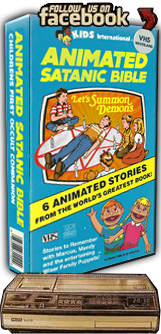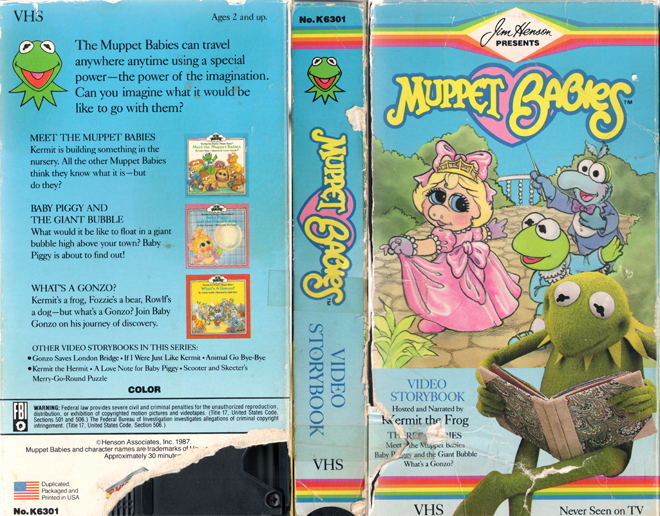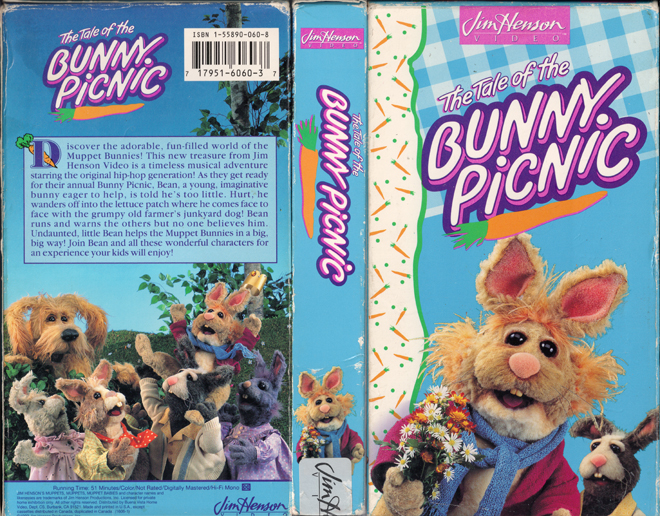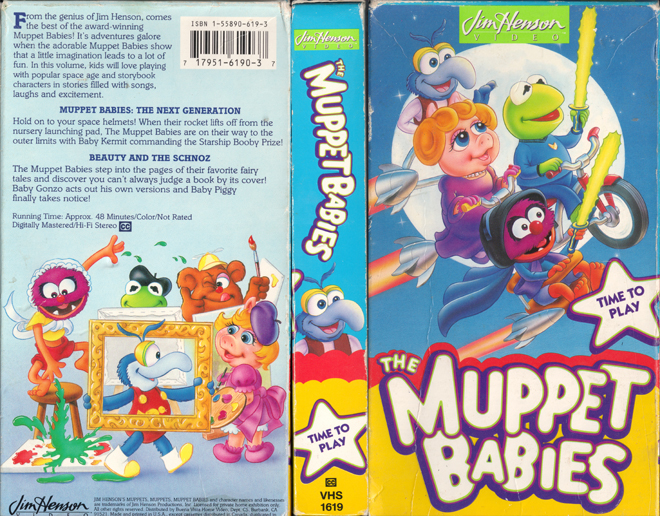 |
|
HELLO AND WELCOME TO VHS WASTELAND, YOUR HOME FOR HIGH RESOLUTION SCANS OF RARE, STRANGE, AND FORGOTTEN VHS COVERS. EACH OF THESE BIZARRE GEMS IS SCANNED AT 200 DPI. SIMPLY CLICK ON THE THUMBNAIL OF ANY VHS COVER TO DOWNLOAD THE FULL HIGH RES FORMAT. WE WILL BE ADDING A NEW COVER DAILY, SO BOOKMARK THIS SITE AND CHECK BACK OFTEN. WE'D ALSO LOVE SUBMISSIONS FROM YOU. IF YOU HAVE A VHS THAT IS WEIRD OR RARE, JUST EMAIL US AT MADHATTERDESIGN@GMAIL.COM. REMEMBER TO SCAN THE FRONT, BACK AND SIDES OF THE VHS AT 300 DPI. WE WON'T ACCEPT LOW RESOLUTION FILES. WHILE YOU'RE HERE, GRABBING OUR AWESOME FREE VHS COVERS, FEEL FREE TO CLICK THE "DONATE" BUTTON ON THE LEFT. IF ENOUGH PEOPLE SEND US SOME CASH, WE MIGHT BE TEMPTED TO KEEP BRINGING YOU THE COOLEST, HIGH RES VHS COVERS ON THE NET. BUT IF YOU GREEDY, COVER GRABBING... I MEAN... YOU WONDERFUL VISITORS TO OUR SITE, DON'T COUGH UP A DONATION, MAYBE WE'LL JUST FIND SOMETHING BETTER TO DO WITH OUR TIME. LIKE GO MAKE NACHOS. MMMMM... NACHOS. SO HELP A BROTHA OUT AND DONATE A LITTLE DOUGH TO THE CAUSE.
LASTLY, WHY NOT VISIT OUR PARENT SITE (SERIALKILLERCALENDAR.COM). IT HAS NOTHING TO DO WITH VHS COVERS BUT I THINK YOU MIGHT BE PLEASANTLY SURPRISED BY WHAT YOU FIND. OR NOT. I DON'T KNOW YOU. MAYBE YOUR NOT SURPRISED BY ANYTHING. MAYBE YOUR THE KIND OF GUY THAT SEES A COW FALL OUT OF THE SKY AND EXPLODE LIKE A PIÑATA AND YOUR ALL LIKE "HUH, THAT WAS WEIRD." MAN. WHAT'S WRONG WITH YOU ANYWAY? JEEZ. SOME PEOPLE.
BUT NO. SERIOUSLY. GO BUY SOME CRAZY AWESOME TRUE CRIME MERCHANDISE AT SERIALKILLERCALENDAR.COM. INCLUDING THE SERIAL KILLER MAGAZINE, THE SERIAL KILLER TRADING CARDS AND MUCH MUCH MORE! DO IT. DO IT NOW. CLICK THE LINK. |

History of The Jim Henson Company
Published at fundinguniverse.com
Address:
5358 Melrose Avenue
Raleigh Studios
Hollywood, California 90038
U.S.A.
Telephone: (213) 960-4096
Fax: (213) 960-4935
https://www.henson.com
Statistics:
Private Company
Incorporated: 1958 as Jim Henson Productions
Employees: 200
Sales: $67 million (1997 est.)
SICs: 7812 Motion Picture & Video Production
Company Perspectives:
The Jim Henson Company is committed to making the world a better place by creating quality entertainment that inspires people to celebrate life and empowers them to follow their dreams. An established leader in family entertainment for more than 40 years, The Jim Henson Company is an independent multimedia production company; one of the top licensors in the industry; a leading publisher of children's books; and home to Jim Henson Television, Jim Henson Pictures, Jim Henson Interactive, Jim Henson's Muppet Workshop, and Jim Henson's Creature Shop.
Company History:
The Jim Henson Company is a leading producer of films, stage shows, television specials, and series for family audiences. More than 75 licensees reproduce the company's characters on toys, books, and other products worldwide, making the company one of the largest players in the product licensing market. The primary attraction to Jim Henson licensees is the variety of distinctive, yet simple characters recognized around the world as Jim Henson's Muppets. Founded by puppeteer Jim Henson in 1955, the company has managed to maintain the highest standards of critical and artistic excellence while becoming a major financial success in the industry. After 35 years of growing financial and critical success, the company experienced a crisis when company founder and president, Jim Henson, died suddenly in 1990 at age 53. Henson's son Brian became president and CEO in 1991 and has continued his father's legacy, leading the company into the interactive computer software market.
Company Origins in the 1950s
Jim Henson combined extreme simplicity in puppet design with sophisticated comedy inspired by the vaudeville and radio performers he had admired in his youth. Many of his creations were little more than socks with eyes, and yet, through subtle manipulation and strong voicing he created characters that have become essential emblems of late 20th-century American culture. Born in Mississippi in 1936, Henson began experimenting with puppets as a child and had his first paying job as a puppeteer in 1954 at a local television station in Washington D.C., before he had finished college. One year later he formed a partnership with Jane Nebel, whom he later married, and the team produced a series of five-minute puppet shows for television entitled Sam and Friends. Sam and Friends introduced audiences to Kermit the Frog, the character that would later become most closely associated with Henson himself, as throughout his career Henson always provided Kermit's voice. By 1956 the Muppets had appeared on national network television on The Steve Allen Show. Henson and Nebel's work on Sam and Friends earned them their first Emmy Award for local television in 1958.
In 1963 the Hensons, along with scriptwriter Jerry Juhl, who had joined the team in 1961, moved their headquarters to New York City, where they were joined by master puppet builder Don Sahlin and versatile performer Frank Oz. Oz was to become the voice behind many of the most famous Muppet characters including Miss Piggy, the prima donna love match to Henson's indomitable Kermit. In 1966 the Muppets had their first of many appearances on The Ed Sullivan Show, the premiere avenue to stardom for variety acts during the period.
National Exposure in the 1970s
After a decade of steadily increasing critical success and popular recognition, the Muppets became part of a larger phenomenon in 1969, when they were featured as an integral part of the Children's Television Network's groundbreaking educational series Sesame Street. The Muppets' connection with Sesame Street assured their enduring popularity and salability for licensing purposes. Parents felt good about their children watching Sesame Street, which stressed education, while the timeless humor of the Muppets appealed to the parents themselves; parents and children became equally attached to the lovable characters. One year after the premiere of Sesame Street, the Jim Henson creation Big Bird appeared on the cover of Time magazine marking both the meteoric rise of the little educational television series and the recognition of the Muppets as cultural icons.
The unusual appeal of the Muppets to both children and adult members of their audience led to a prime time Muppet venture in the mid-1970s entitled the Muppet Show. Aside from Jim Henson perennial Kermit the Frog, all of the characters on the Muppet Show were fresh creations, distinct from their Sesame Street brethren. Although the Muppets had become icons of American popular culture, the first 24 episodes of the Muppet Show were produced at ATV studios in England and sold mostly to independent stations in the United States, including five wholly owned CBS affiliates. Despite its outsider position in the industry and its unusual status as a prime-time family series with puppets, the show became an enormous hit, winning an Emmy Award for variety and comedy series in 1978 and drawing the top talent of the period as guest stars. In the same year a record album based on music from the Muppet Show went platinum and won a Grammy Award for best recording for children.
Although Jim Henson's success depended on simplicity, subtlety, and a fine sense of classic comedy, the production of Muppet films, television series, and stage shows became increasingly high-tech. Eventually the Muppets became associated with both the simple green puppet that was Kermit the Frog as well as the cutting edge in electronically manipulated puppetry called animatronics. Animatronics is a generic term for puppet manipulation whereby the facial features of the puppet are manipulated by remote control from someone not necessarily in physical contact with the puppet. This technique allowed Henson to create enormous puppets which were manipulated by a team of technicians, some of whom would move the puppet's body physically while others would electronically move the eyes, ears, mouth, and so on. In order to create an effective illusion, the team members would all be in contact through headsets. This technology was particularly effective for traveling stage shows, such as Muppet Treasure Island and Muppet Babies Onstage, in which larger puppets were needed to be visible and effective in large theaters.
The fact that Jim Henson's team was on the cutting edge of techno-puppetry meant that its services were in demand for collaborations with other production companies. Under the trademark Jim Henson's Creature Shop, Jim Henson Productions sold its creative technology to a wide variety of other producers, such as film director George Lucas and his special effects company Industrial Light and Magic, which created the fantastical characters featured in the Star Wars series of films in the late 1970s.
Branching Out into Feature Films in the 1980s
The success of the Muppet Show on television prompted Jim Henson Productions to try its hand at a feature film, The Muppet Movie, which premiered in London in 1979. Although audience response to The Muppet Movie was less effusive than it had been to the same cast of characters on the small screen, the film did well enough to ensure a sequel, The Great Muppet Caper, released in 1981.
The Muppet Show went off the air in 1980 after 120 shows, but another film based on the show, The Muppets Take Manhattan, was produced in 1984, and the familiar cast of characters was maintained for other projects on both the large and small screen. Moreover, the company produced other features with new characters; fantasy films The Dark Crystal and Labyrinth, starring David Bowie, both of which were directed by Jim Henson, were produced in the mid-1980s. Fraggle Rock followed the Muppet Show as Henson's next major television venture in 1983, but it never achieved an equivalent broad-based audience appeal. Nevertheless, the company produced 96 episodes before closing Fraggle Rock in 1986, when the show began a lucrative run in syndication.
In 1989 Jim Henson Productions entered into a partnership with Disney. In a deal negotiated by Jim Henson and Disney chief Michael Eisner, Disney acquired Henson Associates Inc., giving Disney the right to use the Muppet characters at its theme parks and on its cable network. Kermit the Frog would later appear in the inaugural special for The Disney Channel while Big Bird would march in the celebratory parade. Disney also agreed to co-produce future projects with Jim Henson Productions. Unfortunately, Henson himself did not live to see the fruit of this deal; he died suddenly of streptococcal pneumonia in 1990, shortly before the release of yet another company feature film, The Witches, based on a book by children's author Roald Dahl. Henson's last project was the creation of Jim Henson's Muppet *Vision 3-D, a featured attraction at the Walt Disney World Resort in Florida.
Continued Expansion in the 1990s
The death of Jim Henson Productions' founder, president, and primary creative force came at a point in the company's history when its future had seemed brighter than ever. To continue his father's legacy, Jim Henson's son Brian Henson was appointed president in 1991. Brian Henson had been trained as a puppeteer by his father and had worked on The Great Muppet Caper, The Muppets Take Manhattan, and Labyrinth, as well as on puppet animation projects with other producers. His directorial debut came in 1992, only one year after being appointed president of the company, with A Muppet Christmas Carol, starring Michael Caine.
In 1993 Jim Henson's Creature Shop began research into refining its animatronic technique to create as high a degree of verisimilitude as possible. Rather than creating only fantastic or comic puppets, the company attempted to create absolutely realistic animals with human characteristics. Following two years of research, new techniques were developed and used to create talking animals with human emotions for the film Babe, produced by Universal Pictures. Babe, the story of a pig and his barnyard friends, was an enormous critical and box-office success, winning the 1996 Oscar for visual effects. Moreover, the success of Babe led to a deluge of films using the new animatronic technology including Disney's 101 Dalmatians and George of the Jungle. Jim Henson's Creature Shop's animatronic technology was equally in demand for television advertising and was eventually used to create 30-second spots for such brands as Carling, Smirnoff, Honda, Mercedes, and Weetabix, among others.
The growth of the company led to the creation of several subdivisions and productive relationships with other corporations in the 1990s. Jim Henson Video and Jim Henson Records were launched in 1993, while the Muppet Press published over 400 different children's book titles. Jim Henson Productions joined forces with Starwave Corporation in 1994 to create a series of educational games on CD-ROM, and as a result of this collaborative venture Jim Henson Interactive was established as a separate division. Jim Henson Productions and Sony Pictures Entertainment agreed to co-produce motion pictures, leading to the creation of Jim Henson Pictures in 1995. Stephanie Allain was named the first president of production at Jim Henson Pictures and the first feature to result from her tenure was Buddy, starring Rene Russo, in 1997. Also during this time, Jim Henson Interactive entered into an exclusive agreement with Microsoft to produce interactive programming for MSN, the third largest online network worldwide.
Muppet toys, clothing, toiletries, and an array of other merchandise comprised more than 75 different licensing deals in the late 1990s, making Jim Henson Productions a major player worldwide. Kermit Hollywood boutiques were opened in the late 1990s to promote Muppet products at leading department stores, while Jim Henson Productions signed an exclusive licensing deal with Galoob Toys to produce toys based on Muppet characters in 1998.
Margaret Loesch was named president of Jim Henson Television Group in 1998. Due to the diversity of Jim Henson Productions' operations and its growing list of divisions and subsidiaries, the company changed its name to The Jim Henson Company in 1998. The newly-named company maintained a healthy creative sector while making the most out of the cast of Muppets inherited from the company's founder Jim Henson. From the simplest beginnings with sock puppets, the Jim Henson Company grew to be a leading producer of special effects, feature films, interactive entertainment, and education, always keeping pace with the latest developments in the industry and public taste. While Jim Henson's untimely death came as a shock to his family, friends, co-workers, and fans, his artistic vision and drive continue to thrive in the company that bears his name.
Principal Divisions: Jim Henson Television; Jim Henson Pictures; Jim Henson Interactive; Jim Henson's Muppet Workshop; Jim Henson's Creature Shop.



|